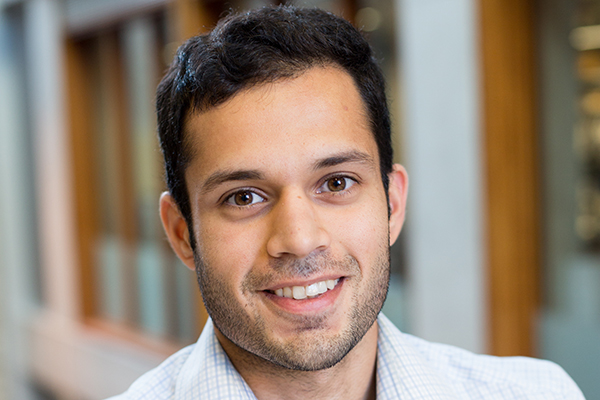Q&A with alumnus, innovator Siddharth Krishnan
Alumnus Siddharth Krishnan has been honored by MIT Technology Review and Forbes magazine for his biomedical innovation that has improved treatment for patients with water on the brain, or hydrocephalus

Siddharth Krishnan didn’t come to Washington University in St. Louis planning to study engineering. He enrolled as an Arts & Sciences student, planning to major in economics and humanities.
What is hydrocephalus and how does your device help those with the condition?
Hydrocephalus is a common condition that affects one in a thousand people at birth. Simply, it's a buildup of fluid in the brain, which can lead to all kinds of problems, including death. It's typically treated with a surgically implanted tube that drains excess fluid into the abdominal area and, as with most things that are implanted in the body, these tubes get clogged and fail fairly often.
My PhD work was a combination of materials science for soft, stretchable, high-quality electronics with a focus on thermal transport measurements. With these devices, we found we were able to make flow measurements on veins and other blood vessels close to the surface of the skin.
Neurosurgeons at Northwestern University saw that my team at the University of Illinois Department of Materials Science and Engineering were making flow measurements on blood vessels, and they asked us to build something similar that could make flow measurements on these cranial shunts. That would save patients a lot of potentially unnecessary imaging and surgeries.
The project was a success and resulted in a couple of big papers and a startup company. That's where we are today.
What challenges did you face trying to take your device to market?
I'll be honest: My co-founder, who was a senior neurosurgical resident at Northwestern, and I didn't come in with any startup experience. We knew the technology, and we knew the clinical need, but, there's so much more that goes into it.
We were lucky enough to enter the Rice Business Plan Competition in 2019. As a part of that, we got two things: Money and experience with writing a business plan.
When it was time to take it to the next stage, we handed it over to a team, including a CEO, with deep experience with medical device commercialization and they are fantastic.
What are you currently working on?
I'm broadly working in the field of biomedical devices, and I transitioned in my postdoc work to focus primarily on diabetes. Specifically, I work with two professors in MIT's chemical engineering department: Bob Langer and Daniel Anderson. Both professors are world-renowned names in the field of drug delivery.
How did your professors impact your training as an engineer?
Back then, I was particularly interested in energy, the environment and those types of applications. I ended up doing research the summer of my sophomore year in the Department of Energy, Environmental & Chemical Engineering in the lab of Richard Axelbaum (The Stifel & Quinette Jens Professor of Environmental Engineering Science). That gave me my start in research and paved the way to the career I have right now.
I also took a great course during my master's studies in the Department of Mechanical Engineering & Materials Science with Srikanth Singamaneni (The Lilyan & E. Lisle Hughes Professor). He's a fantastic professor and brought a lot of passion to his class. The class was soft nanomaterials, and he really convinced me that materials science was the way to go, not just for energy, but for a lot of society's problems.
How did you feel when you learned you were selected as one of Forbes "30 under 30"?
It's a funny thing. Forbes told me I was in the running and asked for references, but then I heard nothing. I assumed that was that, and I wasn't too disappointed. I assumed it was very competitive. I found out I was actually on the list the morning it came out. It was a complete surprise.
MIT Tech Review is a publication I've been reading for over 10 years. It's one of the most interesting and exciting magazines that anyone with a science or engineering interest can have. I've been following the "Innovators Under 35" lists for a long period of time, so to be listed there is pretty cool.
Click on the topics below for more stories in those areas
- Alumni
- Entrepreneurship
- Mechanical Engineering & Materials Science
- Energy, Environmental & Chemical Engineering



